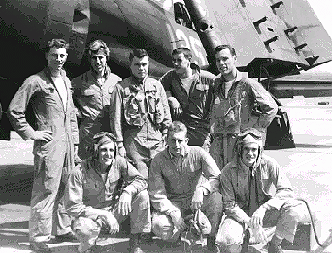Bronson Field – FLT 8 and Instructor
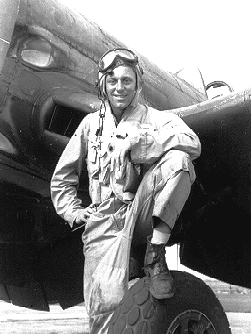 KA-91 after Bob Aumack got her in at Bronson Field, Florida. Note angle of attack starboard wing. Broken spar caused by fatigue. Estimated 5,400 FCLP landings by KA-91 (maximum number 1,800). Happened while Bob was practicing FCLP.
KA-91 after Bob Aumack got her in at Bronson Field, Florida. Note angle of attack starboard wing. Broken spar caused by fatigue. Estimated 5,400 FCLP landings by KA-91 (maximum number 1,800). Happened while Bob was practicing FCLP.
Joined the Navy under the HOLLOWAY PROGRAM (PUBLIC LAW #729), known as the Flying Midshipman Program, and designated Naval Aviator (#T-382) at NAS PENSACOLA on 8 May 1950. Remained a FLYING MID’N Naval Aviator flying with the fleet until commissioned ENSIGN in late August 1950 with date of rank 6/1/50. Assigned to VF-24 with temporary duty in VF-13 at NAS JACKSONVILLE; orders were cancelled when Korean War began and re-ordered to VF-43 when Air Group Four was recommissioned that September at NAAS CECIL FIELD.
Reported to VF-174, NAS JAX, 4/51 as replacement pilot when Air Group Seventeen was readying for deployment. Two Mediterranean cruises in USS FRANKLIN D. ROOSEVELT (CRV-42) flying F4U-5/F4U-4 through end of ‘52. Squadron transitioned to F9F-6 at that time. Dead stick landing in Corsair on F.D.R. 7/51.
Due for shore duty, in October was assigned to FASRON-6 Instrument Flight Training Detachment (IFTD) setting up and instructing in the unit which was the first formal instrument training detachment for fleet Naval Aviators. Received shore duty orders to the Advanced Training Command and reported to ATU-201, NAAS KINGSVILLE 5/54 with further transfer to ATU-204, NAAS CHASE FIELD (6/54) when recommissioned. Aircraft being used at that time was F9F-2. Ordered to the Jet Transition Training Unit (JTTU), NAAS OLATHE in January as part of cadre of F9F-6 fleet pilots to form and instruct in the first Navy unit whose sole mission was to transition fleet prop Naval Aviators into jets. Also provided syllabus for Senior Naval Aviator Officers. Departed JTTU Late August ‘57 for General Line School ten months curriculum.
In June 1953, transferred to Barin Field as an LSO instructor. Returned to the fleet at NAS Miramar as senior LSO for Air Task Group Two under Gus Macri and deployed on the USS Hancock. Biggest scare of Navy career occurred during Operational Readiness Inspection when Billy D. Holder, VA squadron CO, had an emergency. Weather was light rain, low ceiling and a black night as Holder was making a very fast approach. He was cut with the mirror lights and the aircraft passed over the ramp, down the angled deck, power was added and he goes around again, all with his wheels and flaps up. Seems he disconnected his hydraulics when the emergency occurred but he reset the system and came aboard next pass as if he were on rails.
After six weeks of Atomic Weapons School, San Diego (6-7/58) reported to USS RANGER (CVA-61) as Assistant Air Ops. First super carrier on West Coast and when deployed to FAR EAST was showboat for foreign dignitaries. Two cruises to WESTPAC. Second year/cruise was also senior air controller when CIC needed controller organization. Departed RANGER 10/60 to VF-124 F8 RAG at NAS MOFFETT FIELD and reported to VF-191, as Maintenance Officer, the Operations Officer, two WESTPAC deployments in USS BON HOMME RICHARD (CVA-31).
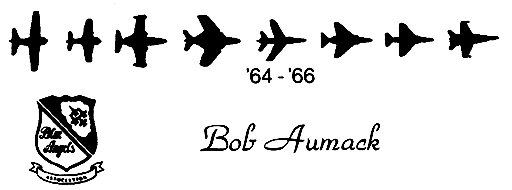
In April 1963 reported to COMFAIRMIRAMAR as VF Training Officer until September 1963 when I reported to the BLUE ANGELS. Officer-in-Charge of United States NAVY FLIGHT DEMONSTRATION TEAM 1964 THROUGH 1966. Out of the country to the Caribbean and Mexico in 1964. First European tour for
Team in 1965. Paris Air Show in June 1965 and recognized by being written into the CONGRESSIONAL RECORD. Left the Team West Coast and fleet duty in March 1967.
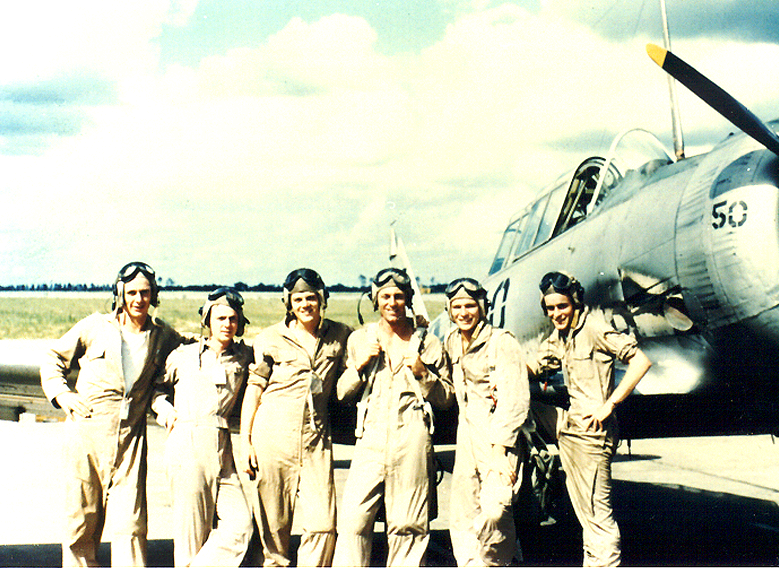 After RAG (VF-124) F8 familiarization, joined VF-162 as XO while deployed in WESTPAC (Tonkin Gulf-YANKEE STATION). Day/night operations in USS ORISKANY (CVA-34) as fighter/bomber in F8E. End of cruise became CO of VF-162, 2/68-2/68. Received first F8Js on West Coast.
After RAG (VF-124) F8 familiarization, joined VF-162 as XO while deployed in WESTPAC (Tonkin Gulf-YANKEE STATION). Day/night operations in USS ORISKANY (CVA-34) as fighter/bomber in F8E. End of cruise became CO of VF-162, 2/68-2/68. Received first F8Js on West Coast.
CARDIV TWO STAFF as Air Warfare Officer from January 1969 through August 1970. Two cruises to the Mediterranean.
Ordered to NAVAL AIR SYSTEMS COMMAND in Late August 1970 as Long Range VF Planning and Design of Future Fighters desk. Deeply involved with other divisions of AIR 03 with missile development at NAS CHINA LAKE and civilian industry development of various simulators (Air Combat maneuvering, G Simulation machines/Devices and the Carrier Approach Simulator). Also worked on paper aircraft which would later become the F-16 and F-18 when Navy interested civilian contractors in light weight fighter designs (Air Force later picked up and completed these designs).
Attended the U.S. NAVAL POSTGRADUATE SCHOOL Baccalaureate Program from January 1973 through April 1975 receiving a degree in International Relations (Government). Also completed Aviation Safety School. Became Operations Officer NAS MIRAMAR in April 1975. Last official Navy flight flown from NAS MIRAMAR 6/30/76 landing at 2350. Retired from U.S. NAVY 6/30/76 at midnight; still lauding the NAVY.
SQDNS/UNITS VF-13, VF-43, VF-174, VF-124, VF-191, VF-162,FASRON-6 (IFTD), ATU-201, ATU-201, ATU-204, JTTU, BLUE ANGELS
A/C FLOWN Min. 1000 hrs/type: F4U-4/5/5N, F9F-2/6/8/8T, F11A,F8A/C/D/E/H/J & RF8A, TV-2
Other: T-28, T-34, T-39, T-2J, T2V, TA4, SNJ, SNB, SBD, S2F, JRB, CIA, FG-1D, F6F, F4D, F-105, P-51
CV EMBARKED TICONDEROGA, BON HOMME RICHARD, ORISKANY, MIDWAY, FRANKLIN D. ROOSEVELT, SARATOGA, RANGER, INDEPENDENCE,
AMERICA,JOHN F. KENNEDY, BLOCK ISLAND, PALAU
FLIGHT HRS 7,200 PLUS
CV LANDINGS 512 (day and night)
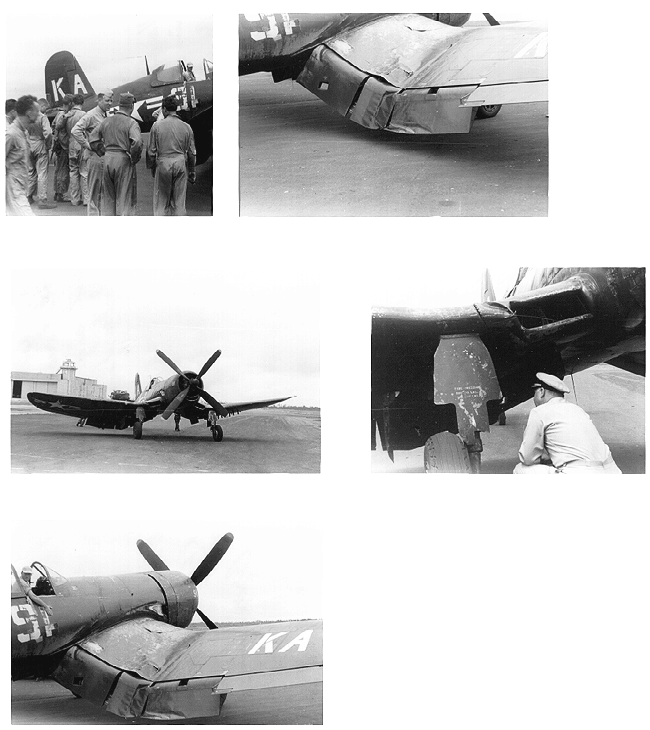
(photograph from Ralph Tvede)
April 28, 1950
Roster of Blue Angels Officers
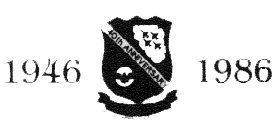
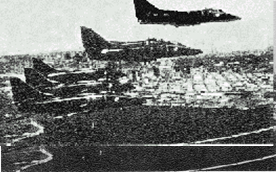
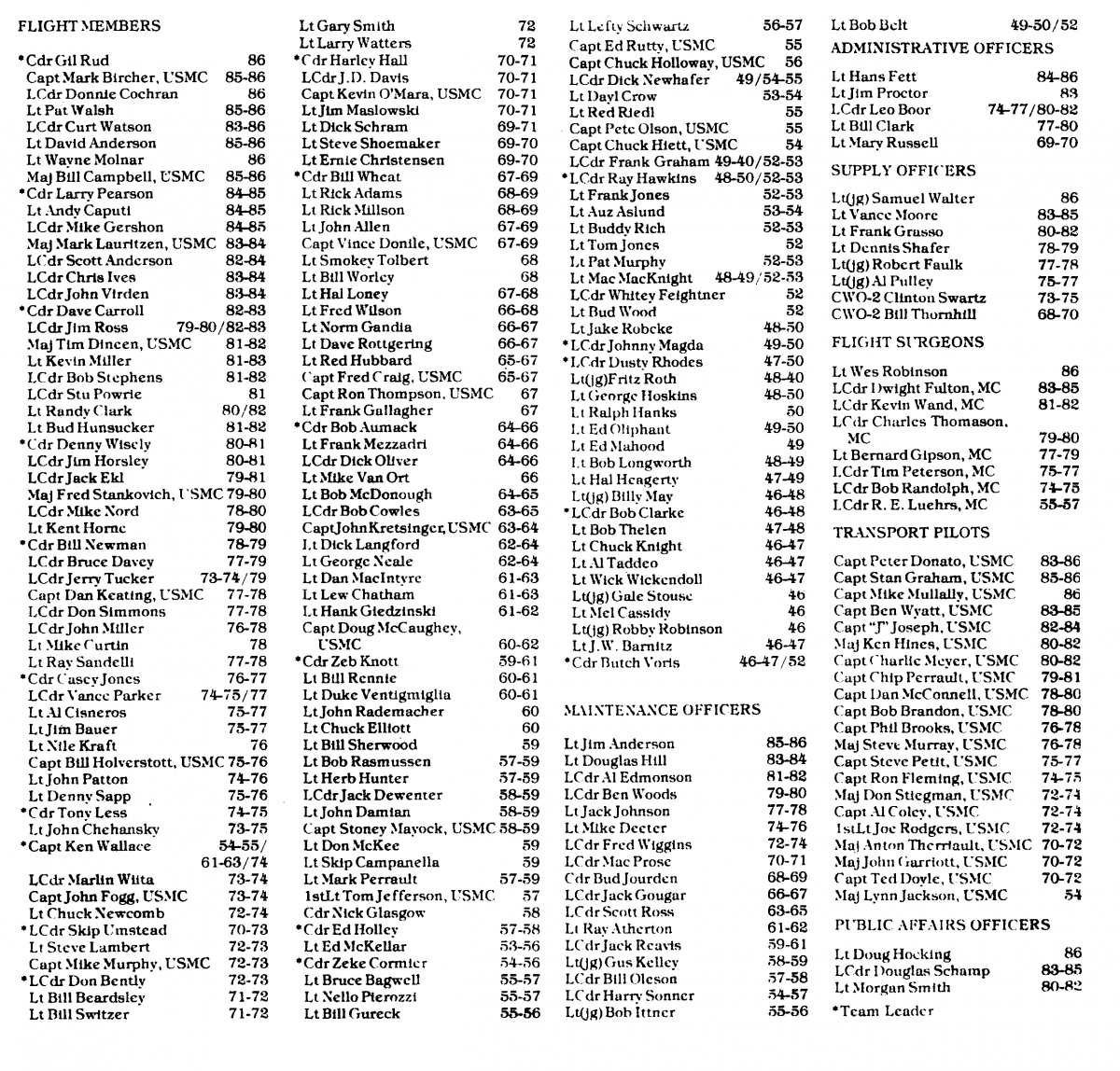
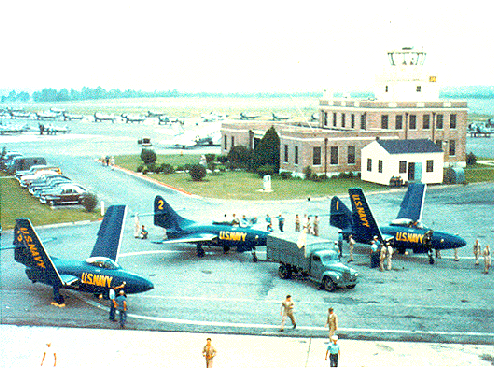
Commander Robert F. Aumack, USN (Retired)
Joined the Navy under the HOLLOWAY PROGRAM (PUBLIC LAW #729), known as the Flying Midshipman Program, and designated Naval Aviator (#T-382) at NAS PENSACOLA on 8 May 1950. Remained a FLYING MID’N Naval Aviator flying with the fleet until commissioned ENSIGN in late August 1950 with date of rank 6/1/50. Assigned to VF-24 with temporary duty in VF-13 at NAS JACKSONVILLE; orders were cancelled when Korean War began and re-ordered to VF-43 when Air Group Four was recommissioned that September at NAAS CECIL FIELD.
Reported to VF-174, NAS JAX, 4/51 as replacement pilot when Air Group Seventeen was readying for deployment. Two Mediterranean cruises in USS FRANKLIN D. ROOSEVELT (CRV-42) flying F4U-5/F4U-4 through end of ‘52. Squadron transitioned to F9F-6 at that time. Dead stick landing in Corsair on F.D.R. 7/51.
THESE ARE THE BLUES F9F-2 PANTHERS AFTER TRANSITION FROM F8Fs. Late July or early August. The first Blue Angels jet A/C.
O-in-C Dusty Rhodes.
DESIGNATED NAVAL AVIATOR # T-582 ON 8 MAY 1950
9/48-4/51 Flight training, designation and assignments as described on pgs 5-6. Joined the fleet 6/50 as a FLYING MIDSHIPMAN until commissioned
ENSIGN in late August 1950 with date of rank 6/1/50.
4/51-10/53 VF-174. Two Mediterranean cruises in USS FRANKLIN D. ROOSEVELT (CVA-42) flying F4U-5/F4U-4 through end of ‘52 when transitioned
to F9F-6. Dead stick landing in Corsair on F.D.R. 7/51 .
10/53-4/54 FASRON-6 (IFTD) Due for shore duty, assigned in setting up and instructing in Instrument Flight Training Detachment for fleet aviators.
(First formal instrument training detachments).
5/54-1/55 Flight instructor at ATU-201, NAAS KINGSVILLE 5/54 and ATU-204, NAAS CHASE FIELD (6/54) when recommissioned.
1/55-8/57 Formed and instructed at Jet Transition Training Unit (JTTU), NAAS OLATHE – the first Navy unit whose mission was to transition
fleet prop Naval Aviators into jets.F9F-6 first experienced pilots were cadre of unit.
9/57-6/58 Attended General Line School at U.S. NAVAL POST-GRADUATE SCHOOL, Monterey, Ca.
7/58-10/60 USS RANGER (CVA-61) as Assistant Air Ops. First super carrier in FAR EAST and was showboat for foreign dignitaries.
Two cruises to WESTPAC. Second year cruise was also senior air controller when CIC needed controller organization.
10/60-2/61 VF-124 F8 RAG at NAS MOFFETT FIELD.
3/61-3/63 VF-191 Maintenance Officer/Operations Officer. Two WEST-PAC deployments in USS BON HOMME RICHARD (CVA-31).
4/63-9/63 COMFAIRMIRAMAR as VF Training Officer.
9/63-3/67 BLUE ANGELS. Officer-in-Charge 1964 through 1966. Out of the country to the Caribbean and Mexico in 1964. First European
tour for Team in 1965. Paris Air Show in June 1965 and recognized by being written into the CONGRESSIONAL RECORD.
3/67-12/68 After RAG (VF-124) familiarization, joined VF-162 as XO while deployed WESTPAC (VIETNAM-YANKEE STATION).
Day/night operations in USS ORISKANY (CVA-31) Commanding Officer VF-162 2/68-12/68 with first F8Js on West Coast.
1/69-8/70 CARDIV TWO STAFF as Air Warfare Officer. Two cruises to Mediterranean.
8/70-12/72 NAVAL AIR SYSTEMS COMMAND (AIR 03). Long range VF Planning and Design of Future Fighters desk. Deeply involved with
other divisions of AIR 03 with missile development at NAS CHINA LAKE and with civilian industry development of various simulators
(Air Combat maneuv-ering/G Simulation machines/Devices/Carrier Approach Simulator). Also worked on paper with what would become
the F-16 and F-18 when Navy sent letters of interest to con-tractors for ideas for lightweight fighter.
1/73-4/75 U. S. NAVAL POSTGRADUATE SCHOOL Baccalaureate Degree Program.
4/75-7/76 Operations Officer NAS MIRAMAR. Retired from U.S. Navy 6/30/76.
21 June 2000
Here are the photographs and copies which you sent to me a couple of weeks ago. They do not belong to me though I do have a passing bit of knowledge about them.
You have all the names correct about the six of us posing at the SNJ. Once we finished F and G stages we were off to Corpus Christi and either single engine or multi-engine training. I'm sure you know that the multi-engine group received their wings at Corpus while those of us who went single engine finished up with CARQUALS back at Corry Field in the Pensacola area. We then went separate ways and for the most part the closeness was gone. I do have a small bit of information on two of the group.
BOB WORCHESEK flew ADs just about all of his Navy career and did quite well. He ended up at C.O. of NAS ALAMEDA and after retiring moved south to BONITA, CALIFORNIA where he still resides with his lovely wife, Joyce. I do see them from time to time, exchange Christmas cards and laugh a lot when we do manage to get together; whether it's for a few minutes or an evening.
THAT IS THE ONE AND ONLY CARLISLE STAFFORD standing 2nd from the right in the photo. Curley was doing FCLP in ADs at BRONSON FIELD one day and while bouncing managed a torque roll taking off after a cut. (A few weeks before a student was killed in the same situation and we all received a lecture on save yourself and don't worry about the airplane.) As the plane rolled Curley pulled off the throttle and managed to survive the ensuing crash without a scratch. Seemed like the thing to do according to the "how to" during the safety speech. Not so!!! Curley went through a Student Pilot Disposition Board and was washed out so there he was, outside looking at the rest of us becoming Naval Aviators.
… and now for the rest of the story …
Curley went back to Bluefield, West Virginia and was gone from sight but not out of our minds. Several of us who knew Curley thought we should find him and see what he was up to as a civilian. The following Thanksgiving off we drove from NAAS CECIL FIIELD on a long weekend trek to Bluefield and the Stafford family. This was a spur of the moment idea where we piled into a car and were off without a serious thought among us on where or how information. It turned out great. We hit Bluefield, found the Stafford home and there was Curley fit as a fiddle and doing fine. It was a great outing although the entire house came down with food poisoning … but that's another story. We left Saturday in our car without a heater system and after a blizzard heading back to the sunny and warm southland. The ice and snow from
West "By God" Virginia still clung to the bottom of the car when we parked it on the streets of Jacksonville and those who saw us had to stop and stare with disbelief. There's a lot more to this part of the story but I'll skip that for now …
Years pass, I complete my sea duty tour and become an instructor at NAAS CHASE FIELD, BEEVILLE, TEXAS. During a X-Country with a group of students we stopped for fuel at BROOKLEY AFB (MOBILE, ALABAMA). I was checking a hydraulic leak in the nose wheel well of an F9F-2 when I heard this southern drawl passing some disparaging remark about Navy Aviators. Exiting the wheel well there was Curley Stafford. He had tired of civilian life, joined the Air Force, got his wings and was flying (of all things) C-124s. When I asked him why the monsters he merely replied he'd had enough of the small stuff. It was the last time I saw Curley and I do hope he's alive and well.
As for your Blue Angels photo, I‘ll be brief. It is SAUFLEY FIELD and 1949 but the birds are F9F-2s, not F8Fs. These were tie first of the jet aircraft the Blues flew. The Diamond (there were no solo pilot performance at that time) consisted of: Leader DUSTY RHODES, #2 George HOSKINS, #3 Fritz RUTH and #4 Jake ROBCKE. Dusty is a dear friend of mine, we get together several times a year and even play a few rounds of golf though I won't say how well.
Hope this has helped.
Keep Smilin’,

P.S.:
Some time ago I remember reading of the first Mid’n in combat since the Spanish American War was a George Strickland. (I think you wrote it.) His name is GORDON and we went through advanced flight training together. Just thought I’d let you know to keep the files correct.

